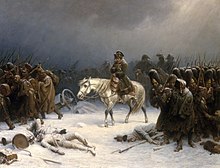retreat

Withdrawal or tactical withdrawal (correct: evasion) describes in military tactics the combat-like detachment from the enemy.
It is a largely orderly withdrawal movement. The escape , on the other hand, is disordered, uncoordinated , sometimes aimless and / or haphazard, sometimes panic .
A Dodge may be required by an attack by superior forces, when the pressure on its troops is too large. It is usually necessary if the encirclement of one's own troops is threatened or the current front or position does not offer an optimal starting position for further actions (offensive as well as defensive), but opens up good opportunities for the enemy (e.g. closing a front arc). Evasion is also spoken of when an attacking force is unsuccessful and is instructed to end their attack and return to their original position. Evasion is mostly covered by a rear guard .
Dodging is also a combat act of a fighter platoon in the hunt from hiding or in a surprising encounter with even inferior enemy forces in order to keep the initiative and not be tied up in passive combat actions.
Controlled retreat under constant enemy influence is often described as the most difficult military maneuver of all.
The sham withdrawal is a ruse . He is already mentioned in the 36 stratagems , which were probably written in the 5th century: "Rested await the exhausted enemy" . On October 14, 1066, the French Normans won the Battle of Hastings by means of a sham retreat (Duke Wilhelm the Bastard defeated the Anglo-Saxons under their King Harald II ).
The mock retreat was also part of the Mongolian warfare .
Well-known examples
- In March 1917, the German troops in the central section of the western front on the Somme withdrew to the Alberich company in the heavily developed Siegfried line . Previously, they largely devastated the released area and partially mined it. With this retreat, the Germans shortened the front line to be defended and withdrew to a line that was particularly easy to defend in many places due to the relief of the terrain.
- With the victory over the German troops on the front line in front of Amiens - Black Day of the German Army (August 8, 1918), the turning point in World War I was finally sealed and the defeat of Germany was only a matter of time. On that day the Germans lost about 30,000 men, half of them were taken prisoner of war , which made an impression on the Supreme Army Command (OHL) . The staff officers demanded permission from Erich Ludendorff to retreat, but he insisted on a defense at all costs. The arranged by him rigid defense would have the tanks of the Allies (10 battalions with 360 heavy British tanks of the type Mark IV , 2 battalions with 96 Cavalry tanks Type Mark A and two battalions with 90 French Renault FT even allow) an even greater success; Ludendorff finally agreed to withdraw the front.
- In 1934/35 the Chinese People's Liberation Army withdrew thousands of kilometers from the Kuomintang troops . This retreat went down in the founding myth of Maoism as the Long March .
- In May / June 1940 the British Army withdrew to England via the English Channel during the Battle of Dunkirk . Its importance lies in the fact that it saved large numbers of British and other Allied soldiers from German captivity. During the German campaign in the west , the northern French city of Dunkirk was the last evacuation port of the British Expeditionary Force . The British and French succeeded in defending the bridgehead until over 330,000 Allied soldiers were brought to safety in Operation Dynamo before the Germans took the city. 40,000 Allied soldiers, mostly French, went into German captivity; the Wehrmacht captured 50,000 vehicles of all types and other heavy military equipment.
- The withdrawal from the northern foothills of the Caucasus in 1943 was one of the few military retreat operations by the Wehrmacht in which the entire army group and all heavy equipment were not lost.
Hitler repeatedly interfered in planned or ongoing retreat operations of his generals and believed that he could achieve something through slogans or orders like "to the last man" (or stone or drop of blood). This often led to units being encircled in permanent places or to the fact that the retreat was hasty "at the last minute" (ordered, approved or unapproved). The Wehrmacht fought numerous retreats
- on the Eastern Front after the defeats in the Battle of Stalingrad (winter 1942/1943) and on the Kursk Arc (summer 1943). The retreats ended in the pocket of Halbe (southeast of Berlin) and in the battle for Berlin .
- on the western front :
- since the Allied landings in Sicily in July 1943
- since June 1944 against the Allies who landed in Normandy were
- since August 1944, when the Western Allies landed in the Rhone Delta
- 1945 when the Battle of the Bulge and Operation Nordwind failed and from then on across the front; part of the withdrawal ended in April 1945 in the Ruhr basin (in the Rhineland , in the Ruhr area and in Westphalia )
See also
literature
- Sunzi : The Art of War . approx. 500 BC Chr.
- Albert von Boguslawski: The development of tactics from 1793 to the present, Volume 1. Berlin, 1869.
- William Balck: Development of Tactics in World Wars. R. Eisenschmidt, 1922.
Web links
Individual evidence
- ^ Reichsarchiv, Battles of the World War , Volume 36, Stalling, Oldenburg i. O./Berlin, 1930, p. 26.
- ^ Liddell Hart , BH: History of the Second World War . GP Putnam, New York 1970, ISBN 0-306-80912-5 , pp. 46 (English).
